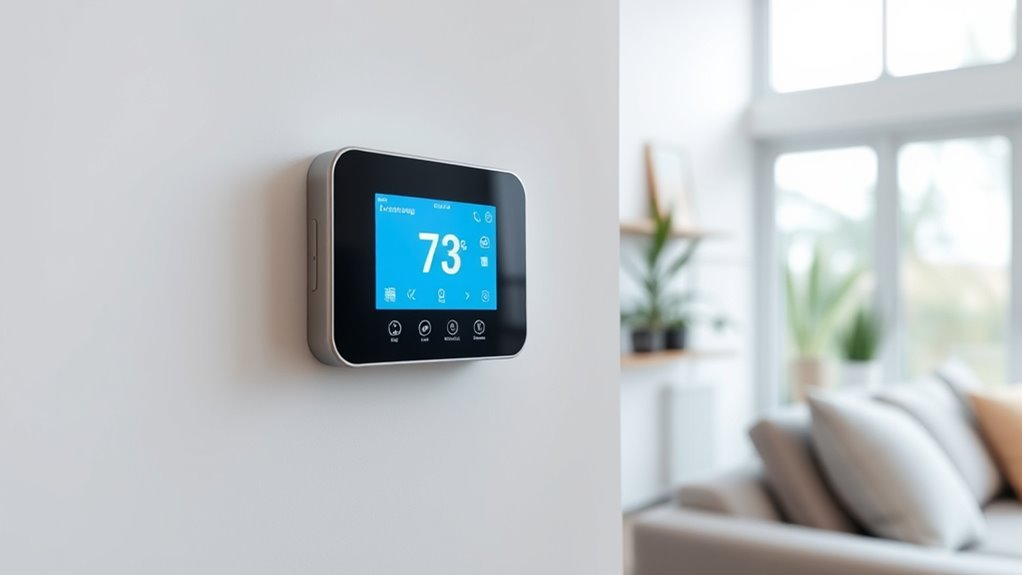If you’re looking for the best Wi-Fi baseboard thermostats of 2025, I recommend considering models like Mysa, meross, MOES, and KING K901-W for reliable smart control and energy savings. Many support smart home platforms like Alexa and Google, making them easy to integrate. Some are simple manual units, while others offer detailed scheduling and energy insights. Keep in mind wiring needs and system compatibility—if you’re curious about which fits your setup, you’ll find plenty of helpful details below.
Key Takeaways
- Focus on high-voltage, Wi-Fi-enabled thermostats compatible with electric baseboard and radiant heating systems.
- Prioritize models with easy DIY installation, app control, and smart home ecosystem integration (Alexa, Google, Apple).
- Consider features like energy monitoring, adaptive scheduling, and Matter support for future-proof automation.
- Check for reliable Wi-Fi connectivity and compatibility with existing wiring, including the need for neutral or second live wire.
- Review customer ratings and firmware update support to ensure long-term performance and smart home comfort.
Mysa Smart Thermostat LITE for Baseboard Heaters
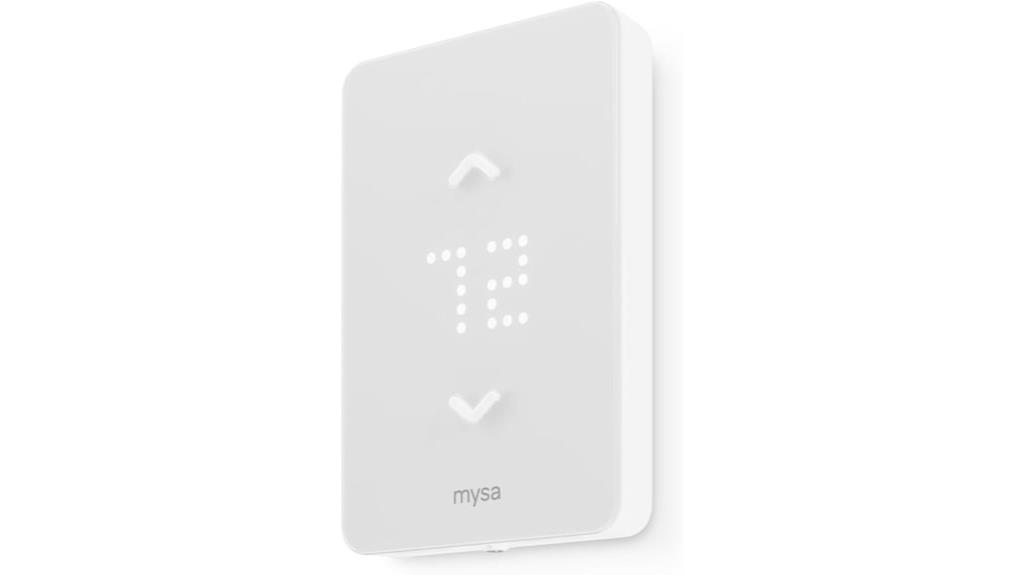
Looking for a smart thermostat that makes controlling your baseboard heaters easy and energy-efficient? The Mysa Smart Thermostat LITE is a fantastic choice. It controls line voltage electric heating systems like baseboards, fan-forced heaters, wall heaters, and convectors, compatible with 120V-240V setups. Installation is simple—just four wires and a quick DIY video guide—no electrician needed. It offers remote control via an app, supporting voice commands through Alexa, Google Assistant, or Apple HomeKit. With features like scheduling, energy reports, and geofence technology, you can optimize comfort and save up to 26% on heating costs. Plus, it’s UL certified and backed by a 2-year warranty.
Best For: homeowners or DIY enthusiasts seeking an easy-to-install, energy-efficient smart thermostat for line voltage baseboard heaters and similar high-voltage heating systems.
Pros:
- Easy 4-wire installation with step-by-step video guidance, no electrician needed
- Supports remote control, scheduling, energy reports, and voice commands via popular smart assistants
- Helps save up to 26% on heating costs through smart scheduling and energy monitoring
Cons:
- Limited to high-voltage (line voltage) systems; not suitable for low-voltage or two-wire setups
- Requires at least four wires (neutral or second live wire), which may not be available in all installations
- First available date listed as April 17, 2025, which may delay purchase for immediate needs
meross Smart Thermostat for Electric Baseboard and In-Wall Heaters
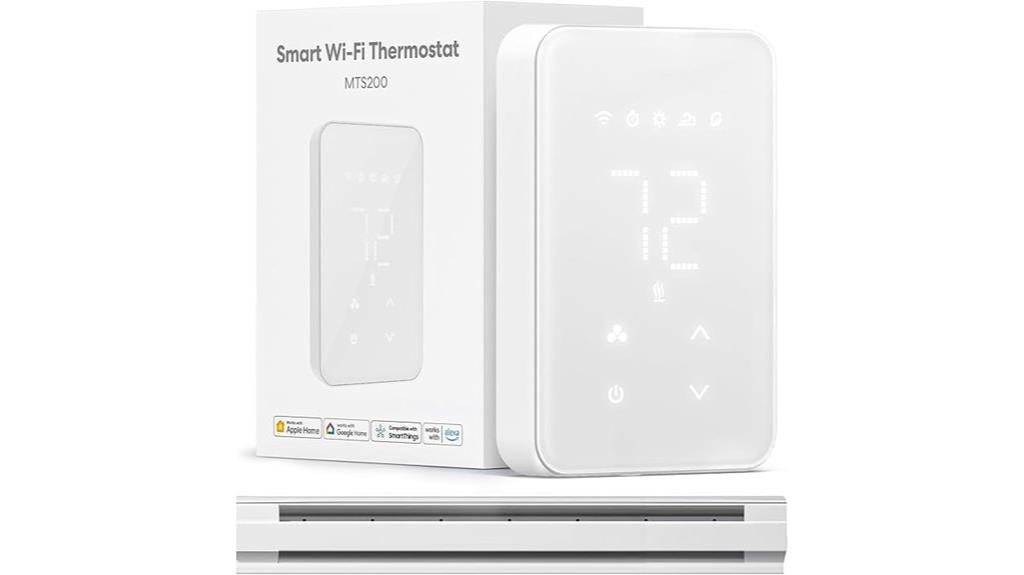
The meross Smart Thermostat is an excellent choice for homeowners seeking a versatile and easy-to-install solution for electric baseboard, in-wall, and radiant heaters. It supports 120V-240V systems and high loads up to 16A, making it suitable for various setups. With compatibility for Apple HomeKit, Alexa, Google Home, and SmartThings, it integrates seamlessly into smart homes. Installation takes about 30 minutes, requiring minimal wiring. The sleek LCD display offers precise temperature control from 41°F to 95°F, and the app provides scheduling, energy monitoring, and automation features. Its energy-saving functions and reliable connectivity make it a practical, user-friendly upgrade for your heating system.
Best For: homeowners seeking an easy-to-install, versatile smart thermostat compatible with various voice assistants and capable of controlling electric baseboard and in-wall heaters.
Pros:
- Easy installation within 30 minutes requiring minimal wiring
- Supports multiple smart home platforms including Apple HomeKit, Alexa, Google Home, and SmartThings
- Provides precise temperature control with scheduling, energy monitoring, and energy-saving features
Cons:
- Requires at least 4 wires in the electric box for installation
- Power consumption monitoring features may be limited without additional setup
- No built-in batteries; dependent on wired power supply for operation
Mysa Smart Thermostat for Electric Baseboard Heaters

If you’re seeking a smart thermostat that seamlessly integrates with high-voltage electric baseboard heaters, then the Mysa Smart Thermostat is an excellent choice. Designed specifically for 120–240V systems, it supports loads up to 3800W and requires at least four wires, including neutral or a second live wire. Its compact design features adaptive display technology with adjustable brightness, and you can control it via app, voice, or buttons. It offers smart features like scheduling, geofencing, energy insights, and compatibility with Alexa, Google Assistant, and Apple HomeKit. Installation is straightforward, making it a reliable upgrade for modern, energy-efficient home heating control.
Best For: homeowners with high-voltage electric baseboard heaters seeking a smart, energy-efficient, and easily controllable thermostat compatible with voice assistants.
Pros:
- Supports high wattage loads up to 3800W at 240V, suitable for large electric heating systems
- Compatible with popular smart home platforms like Alexa, Google Assistant, and Apple HomeKit
- Features adaptive display technology with adjustable brightness and user-friendly app control
Cons:
- Requires at least four wires, including neutral or second live wire, limiting compatibility with some existing setups
- Not suitable for low-voltage or two-wire systems
- Installation may be more complex for users unfamiliar with high-voltage wiring
MOES Programmable Smart Thermostat for Electric Baseboard Heaters

For those seeking precise temperature control and remote accessibility for their electric baseboard heaters, the MOES Programmable Smart Thermostat is an excellent choice. It connects seamlessly to 2.4G WiFi networks, allowing you to control your heater remotely via the Smart Life or TUYA app. Compatible with Alexa and Google Home, it offers hands-free operation. Designed for high-voltage systems like 120V or 240V, it requires at least four wires, including a neutral or second live wire. Its frosted display reduces glare, and the easy-grip knob provides manual control. This thermostat helps optimize energy use, reduce costs, and maximize comfort.
Best For: homeowners and property managers seeking precise, remote-controlled temperature management for electric baseboard heaters in high-voltage systems.
Pros:
- Compatible with 2.4G WiFi networks for easy remote access via the Smart Life/TUYA app.
- Supports voice control through Alexa and Google Home for hands-free operation.
- Features a frosted display that reduces glare and an easy-grip knob for manual adjustments.
Cons:
- Requires at least four wires, including neutral or second live wire, for installation.
- Designed specifically for high-voltage systems, limiting use in low-voltage applications.
- May require professional installation due to high-voltage wiring and wiring complexity.
Wi-Fi Smart Thermostat for Electric Baseboard Heaters
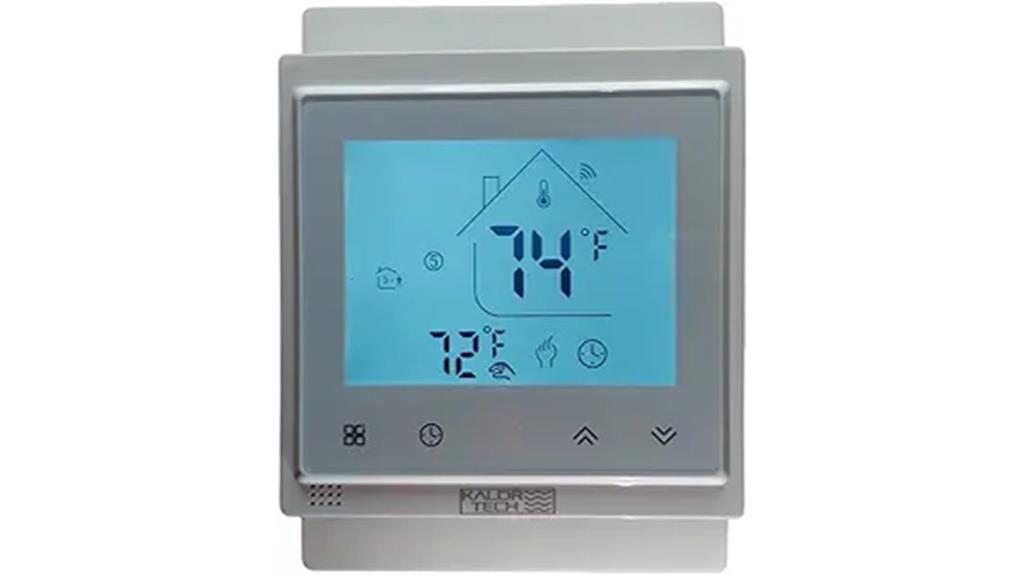
A Wi-Fi smart thermostat tailored specifically for electric baseboard heaters offers precise temperature control and remote management, making it an ideal choice for homeowners seeking convenience and energy efficiency. Designed for 120-240V systems, it features an LCD display showing current temperature, target settings, and Wi-Fi status. Easy to install with a proprietary wall plate fitting standard electrical boxes, it supports app control via Smart Life or Tuya, plus voice commands through Alexa and Google Assistant. You can manage your heater from anywhere, set schedules, or override programs instantly. Compact and stylish, it combines modern design with reliable connectivity to optimize comfort and save energy effortlessly.
Best For: homeowners with electric baseboard heaters seeking convenient, remote-controlled, and energy-efficient temperature management.
Pros:
- Supports remote control and scheduling via app and voice commands, enhancing convenience.
- Easy to install with a proprietary wall plate compatible with standard electrical boxes.
- Compatible with Alexa and Google Assistant for seamless voice integration.
Cons:
- Limited to 120-240V electric baseboard systems; not suitable for 24V central or single-pole systems.
- Requires a 2.4 MHz Wi-Fi network, which may pose connectivity issues in some homes.
- Customer ratings are moderate, indicating potential variability in user experience or performance.
Sensi Lite Smart Thermostat
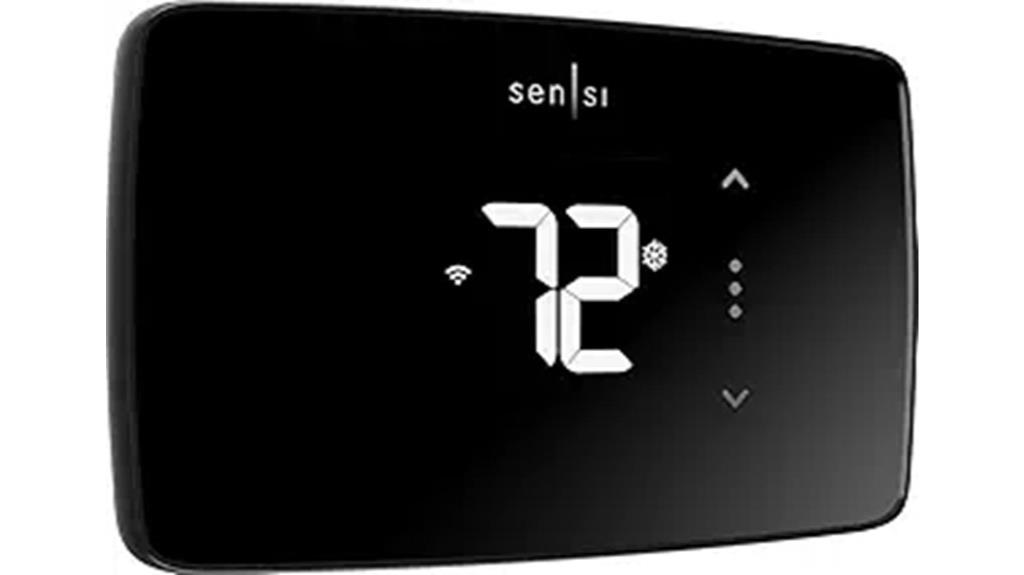
Looking for an easy-to-install smart thermostat that offers reliable Wi-Fi control? The Sensi Lite Smart Thermostat fits the bill perfectly. It features simple DIY installation with a built-in level and step-by-step instructions, making setup straightforward. Compatible with most HVAC systems, needing only a C-wire for heat pumps or heat/cool setups. It’s Energy Star certified, helping you cut about 23% on energy costs through flexible scheduling, geofencing, and remote access. You can control it from anywhere using the mobile app on Android or iOS. Plus, Sensi values your privacy, not selling data or using activity info for ads, ensuring peace of mind.
Best For: homeowners seeking an easy-to-install, energy-efficient smart thermostat with reliable Wi-Fi control and privacy assurance.
Pros:
- Easy DIY installation with built-in level and step-by-step instructions
- Compatible with most HVAC systems, requiring only a C-wire for certain setups
- Energy Star certified, helping save approximately 23% on HVAC energy costs
Cons:
- May require a C-wire for heat pump and heat/cool systems, not necessary for most setups
- Limited advanced programming features compared to more premium models
- Does not offer a touchscreen interface, relying solely on the mobile app for control
Meross Smart WiFi Thermostat with Matter, Alexa, Apple Home & Google Assistant Compatibility

If you’re seeking a versatile and easy-to-install Wi-Fi thermostat that seamlessly integrates with major smart home platforms, the Meross Smart WiFi Thermostat with Matter is an excellent choice. It supports 95% of HVAC systems, including heat pumps and conventional heating or cooling, but not electric baseboards. It requires a C-wire or a Meross adapter for installation and connects only via 2.4GHz Wi-Fi. With Matter support, it works effortlessly with Apple HomeKit, Alexa, Google Assistant, and Samsung SmartThings, allowing remote control, scheduling, and automation. Users praise its sleek design, reliable performance, and compatibility, making it an accessible upgrade for modern smart homes.
Best For: homeowners seeking a versatile, easy-to-install smart thermostat compatible with major platforms and capable of optimizing energy efficiency.
Pros:
- Supports 95% of HVAC systems, including heat pumps and conventional heating/cooling systems
- Seamless integration with Apple HomeKit, Alexa, Google Assistant, and Samsung SmartThings via Matter
- Sleek, durable design with easy app control and reliable Wi-Fi connectivity
Cons:
- Requires a C-wire or Meross adapter for installation; not compatible with electric baseboard heaters
- Limited to 2.4GHz Wi-Fi networks, which may be restrictive in some setups
- No built-in geofencing feature, though automations can be achieved through compatible platforms
Honeywell Home CT410B Manual 4-Wire Thermostat

The Honeywell Home CT410B Manual 4-Wire Thermostat is ideal for those seeking a straightforward, line-voltage control for electric baseboard heating systems. It’s non-programmable and works with 120-240V systems, making it suitable for electric baseboards, convectors, and non-inductive heaters. Its simple bimetal temperature sensor ensures reliable operation, and the 4-wire design offers a positive OFF switch. You can control single or multiple heaters as long as the total load stays below 5280W. With a temperature range of 40°F to 80°F, this thermostat provides basic manual control without any smart features, perfect for those who prefer simplicity.
Best For: homeowners or property managers seeking a simple, reliable manual line-voltage thermostat for electric baseboard or convector heating systems without any programming features.
Pros:
- Easy to install with a 4-wire design offering a positive OFF switch
- Reliable bimetal temperature sensor for straightforward operation
- Suitable for a wide range of voltages (120-240V) and loads up to 5280W
Cons:
- No programmable or smart features for automated temperature control
- Limited to manual operation, may not suit those wanting remote or scheduled control
- Temperature range is fixed between 40°F and 80°F, which might not meet specific comfort preferences
KING K902-B Hoot WiFi Line Voltage Smart Thermostat
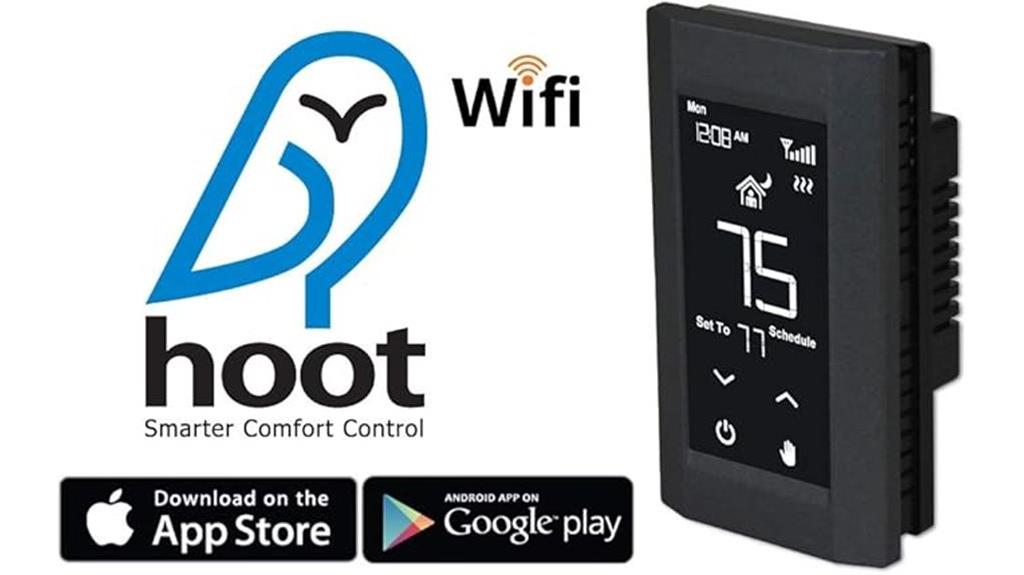
The KING K902-B Hoot WiFi Line Voltage Smart Thermostat stands out as an ideal choice for those seeking precise and convenient control over their electric baseboard or radiant heating systems. Its large LCD touchscreen makes programming easy, offering up to 6 time periods per day for flexible scheduling. Compatible with 120/208/240V systems and supporting a double pole, 4-wire setup, it ensures safe, reliable operation. I appreciate its electronic thermistor sensing, which maintains temperature within ±1ºF, and the ability to control it remotely via the Hoot app. Firmware updates and safety lock features add to its versatility, making it a smart upgrade for any electric heating system.
Best For: homeowners or property managers seeking a reliable, programmable WiFi thermostat for electric baseboard, fan-forced, or radiant heating systems with precise temperature control and remote access.
Pros:
- Easy-to-use large LCD touchscreen display for programming and adjustments
- Supports multiple voltage systems (120/208/240V) with a safe double pole, 4-wire installation
- Features over-the-air firmware updates and smartphone app control for convenience and future-proofing
Cons:
- Requires proper electrical wiring for double pole, 4-wire setup, which may need professional installation
- Limited to line voltage electric heating systems; not compatible with low-voltage HVAC systems
- Temperature accuracy within ±1ºF may not meet the needs of users requiring extremely tight control
Honeywell Home Smart Thermostat (X2S)

Designed for homeowners seeking a reliable, Wi-Fi-enabled thermostat, the Honeywell Home Smart Thermostat (X2S) excels in controlling conventional and heat pump systems with ease. It supports up to 2 heat/2 cool configurations and is ENERGY STAR certified. Compatible with Alexa, Google Assistant, and Apple HomeKit, it offers app, voice, and manual control. The thermostat features a clear LCD display, customizable faceplates, and flexible scheduling options. While installation is straightforward for those with existing wiring, some users face Wi-Fi connectivity issues. Overall, it’s a solid choice for energy savings and smart home integration, though support and setup can sometimes be challenging.
Best For: homeowners seeking a reliable, Wi-Fi-enabled thermostat compatible with conventional and heat pump systems, with smart home integration options.
Pros:
- Supports multiple smart home platforms including Alexa, Google Assistant, and Apple HomeKit for flexible control
- ENERGY STAR certified, promoting energy savings and efficiency
- Customizable scheduling and display settings for personalized comfort
Cons:
- Wi-Fi connectivity issues reported by some users, requiring troubleshooting and support
- Limited automation capabilities within Apple HomeKit compared to other platforms
- Smaller display size can be challenging for users with visual impairments or in bright environments
Programmable WiFi Smart Thermostat with APP Control and Voice Compatibility
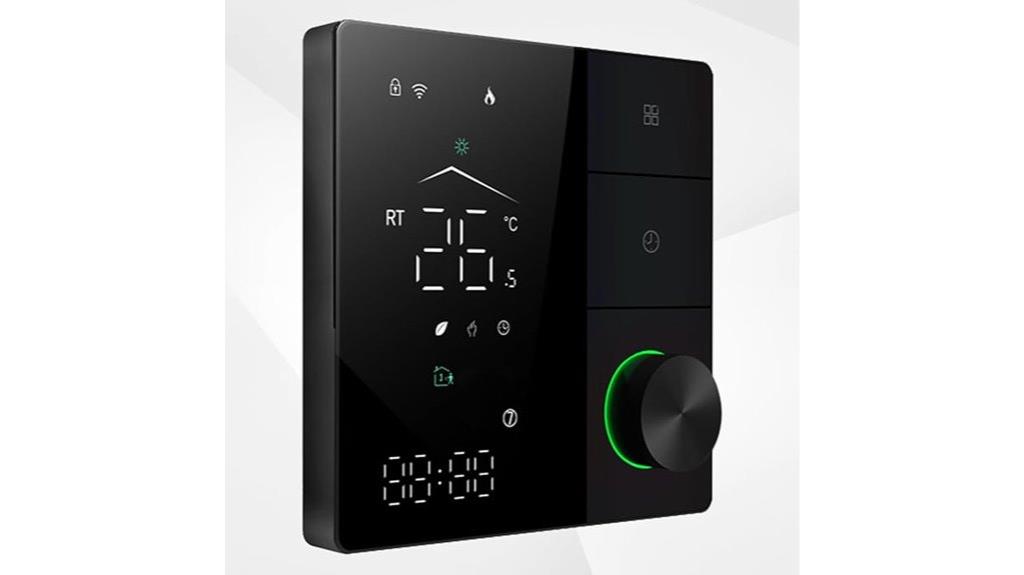
If you’re looking to upgrade your home heating control, a programmable WiFi smart thermostat with app control and voice compatibility offers unmatched convenience. It supports Matter protocol, ensuring seamless integration with Apple HomeKit, Alexa, and Google Assistant, plus compatibility with the Tuya app for broader smart home connectivity. Designed for electric systems like baseboard heaters, it handles up to 16A at 95-240V. You can schedule weekly heating cycles, saving about 35% energy. Control it remotely via app, voice, or touch screen, with features like weather forecast, child lock, and auto-reconnection. Easy to install, it’s perfect for building a smarter, more efficient home.
Best For: homeowners seeking an energy-efficient, easy-to-install smart thermostat compatible with multiple voice assistants and smart home ecosystems.
Pros:
- Supports Matter protocol for seamless integration with Apple HomeKit, Alexa, and Google Assistant
- Offers comprehensive scheduling options with 7-day programming and 6 stages per day, promoting energy savings
- User-friendly installation and operation with app control, voice compatibility, and features like weather forecast and child lock
Cons:
- Designed specifically for electric heating systems, limiting use with other heating types
- May require a converter for compatibility with certain junction boxes during installation
- Advanced features and connectivity options might be complex for users unfamiliar with smart home technology
Honeywell Home RTH6580WF Wi-Fi 7-Day Programmable Thermostat, White
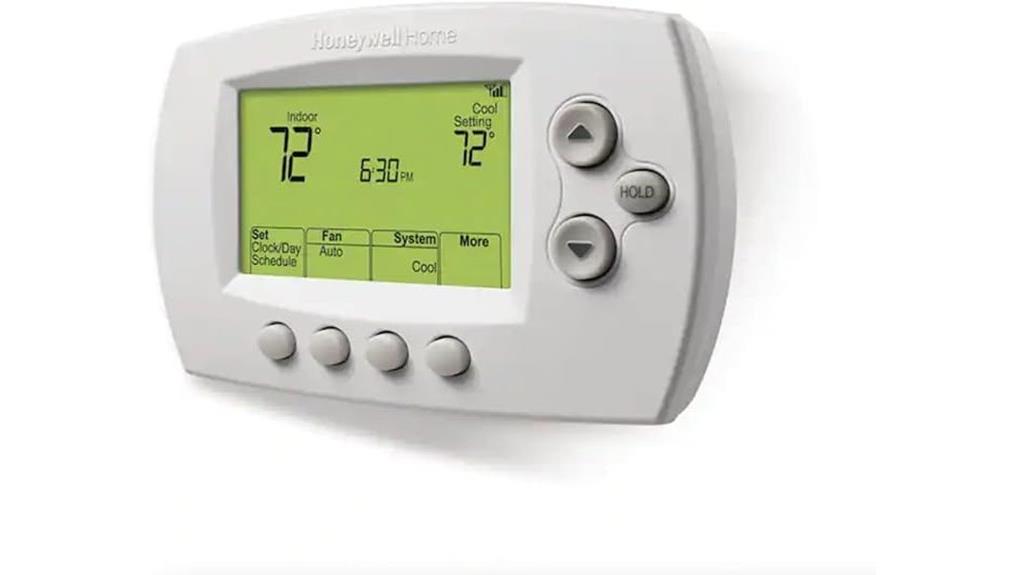
Looking for a smart thermostat that simplifies control over your home’s heating schedule? The Honeywell Home RTH6580WF Wi-Fi 7-Day Programmable Thermostat makes it easy to manage your comfort remotely via the Total Connect Comfort or Honeywell Home app. It works with forced air systems, hot water, steam, and heat pumps (with electric backup), but not electric baseboard heat. The device features a large, backlit display and learns your household routines to optimize heating. It’s Energy Star certified, helping you save energy and money. Installation is straightforward, but you’ll need a C-wire for power. Overall, it’s a reliable, user-friendly choice for smart home heating control.
Best For: homeowners seeking an easy-to-use, Wi-Fi-enabled thermostat that can optimize heating schedules and integrate with smart home systems.
Pros:
- Compatible with a variety of heating systems including forced air, hot water, steam, and heat pumps with electric backup
- Supports remote control and scheduling via the Honeywell Home or Total Connect Comfort app
- Energy Star certified, promoting energy savings and utility bill reduction
Cons:
- Requires a C-wire for power, which may necessitate additional wiring or a power adapter
- Not compatible with electric baseboard heat (120-240V)
- Installation and setup may be challenging for those unfamiliar with wiring or smart thermostats
KING K901-W WiFi Smart Programmable Thermostat

The KING K901-W WiFi Smart Programmable Thermostat is an excellent choice for homeowners seeking precise temperature control and convenient remote management of their electric heating systems. Its large LCD touchscreen makes navigation straightforward, while the compatibility with 120/208/240V multi-voltage systems ensures versatile installation options. You can easily program up to six periods per day, tailoring your heating schedule to your needs. The thermostat’s thermistor provides accurate temperature readings within ±1ºF, and the smartphone app allows remote adjustments. Plus, over-the-air firmware updates maintain the device current, and safety features like maximum temperature lock add peace of mind.
Best For: homeowners seeking precise, programmable control and remote management of electric heating systems in multi-voltage setups.
Pros:
- Large LCD touchscreen for easy navigation and programming
- Compatible with 120/208/240V systems for versatile installation
- Smartphone app control and over-the-air firmware updates for convenience and up-to-date features
Cons:
- Designed primarily for single pole, 3-wire setups; may not suit more complex wiring systems
- Limited to electric heating systems; not compatible with other HVAC types
- Requires WiFi connectivity for remote features, which may not be ideal in areas with poor internet access
RTH9585WF1004 Wi-Fi Smart Color Thermostat
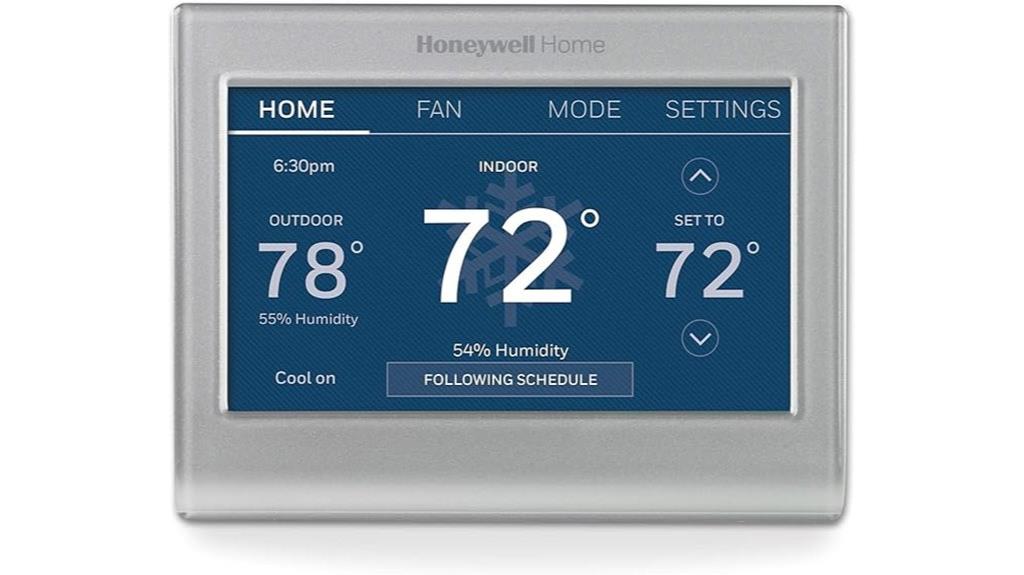
The RTH9585WF1004 Wi-Fi Smart Color Thermostat is an excellent choice for homeowners who want personalized control and energy savings. Its customizable color options let you match your décor effortlessly. The bright touchscreen makes setup and daily adjustments simple, while its compatibility with various HVAC systems ensures flexible installation. It’s Energy Star certified, helping you cut energy use with scheduled programming and real-time monitoring. Plus, you can control it remotely via Wi-Fi or voice commands with Alexa. If your system has a C-wire, installation is straightforward. Overall, this thermostat combines style, smart features, and energy efficiency for a more comfortable home.
Best For: homeowners seeking a customizable, energy-efficient Wi-Fi thermostat compatible with various HVAC systems and smart home integration.
Pros:
- Personalized color options to match home décor
- Easy-to-read touchscreen for simple operation
- Compatible with Alexa for voice control and remote management
Cons:
- Requires a C-wire for installation, which may not be present in all systems
- Not compatible with electric baseboard heating (120-240V)
- Setup may be complex for those unfamiliar with HVAC wiring
MAXKOSKO WiFi Smart Thermostat for Electric Floor Heating System
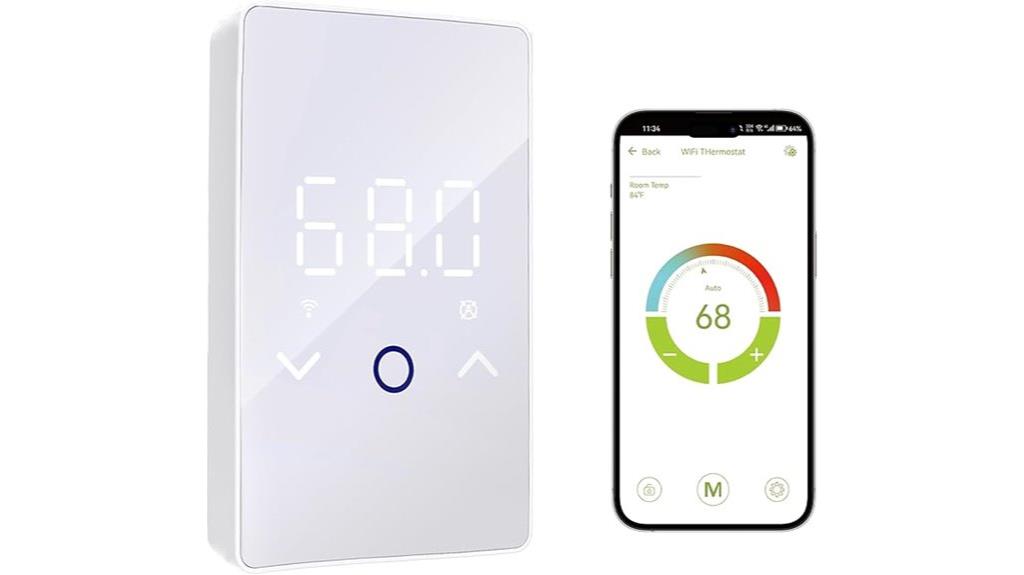
If you want seamless control over your electric floor heating, the MAXKOSKO WiFi Smart Thermostat is an excellent choice. With its smart remote control via the Smart Life app, you can easily adjust your home’s temperature from anywhere. It’s compatible with Alexa and Google Assistant, so voice commands make it even more convenient. The thermostat offers programmable settings to optimize comfort and save energy, plus a 15-foot floor sensor guarantees accurate temperature regulation. Its sleek touchscreen design makes installation straightforward, and the app provides insights into energy use. Designed for reliability and efficiency, the MAXKOSKO thermostat helps keep your home warm and bills low.
Best For: homeowners seeking a smart, energy-efficient solution to remotely control and automate their electric floor heating system with easy installation and voice compatibility.
Pros:
- Convenient remote control via smartphone app, compatible with Alexa and Google Assistant
- Programmable settings for customized comfort and energy savings
- Includes a 15 ft floor sensor for accurate temperature regulation and reliable performance
Cons:
- Requires WiFi connectivity for remote features, which may not be ideal in areas with poor internet
- Installation may be challenging for those unfamiliar with electrical devices, despite the manual
- Compatibility limited to systems supporting 120V/240V power supply
Factors to Consider When Choosing a Wi-Fi Baseboard Thermostat
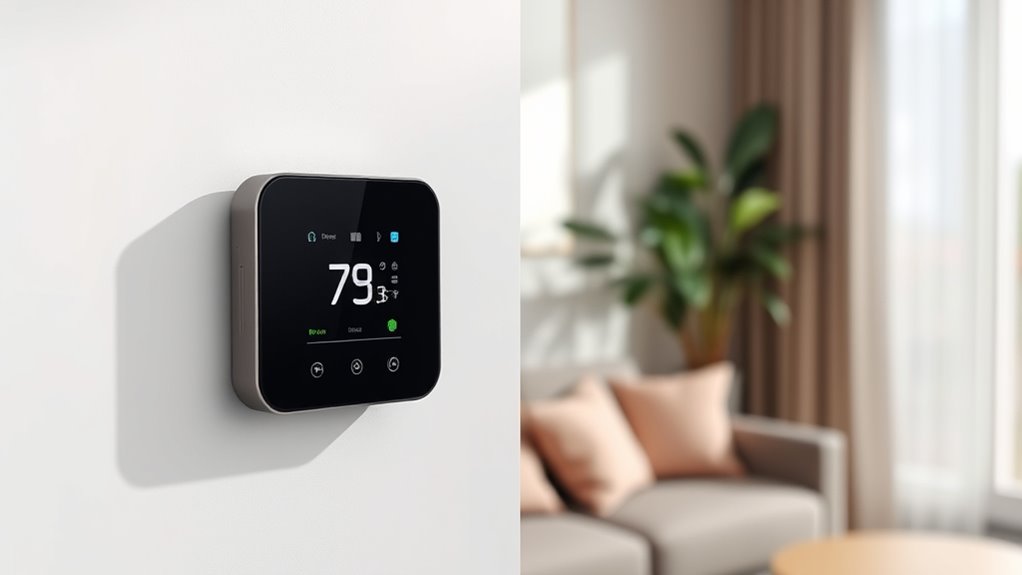
When selecting a Wi-Fi baseboard thermostat, I focus on how well it matches my system type and guarantees a stable Wi-Fi connection. I also consider features like programmable schedules and how easily it integrates with my smart home devices. Making the right choice means balancing compatibility, reliability, and convenience.
Compatibility With System Type
Choosing a Wi-Fi baseboard thermostat requires guaranteeing it matches your specific system type to work properly. First, verify that it’s compatible with your voltage system—whether that’s 120V, 208V, or 240V—to avoid installation issues. Next, confirm the thermostat supports your heating setup, like baseboard heaters, convectors, or radiant ceiling heaters. Wiring requirements are also vital; most thermostats need at least four wires, including a neutral or second live wire, for proper operation. Additionally, check if it’s compatible with your existing control system—whether it’s high-voltage line voltage or low-voltage (24V). Lastly, if you want smart home integration, guarantee the thermostat or its app supports your preferred ecosystem, such as Alexa, Google, or Apple HomeKit.
Wi-Fi Connectivity Stability
Reliable Wi-Fi connectivity is vital for your thermostat to function smoothly and respond accurately to remote commands. A stable connection ensures your device can reliably control temperature settings and automation features without interruptions. To achieve this, look for thermostats that support dual-band Wi-Fi (2.4GHz and 5GHz), which helps reduce interference and improve connection stability. Consistent firmware updates are also important, as they fix bugs and optimize network performance over time. Additionally, signal strength and proximity to your router matter—weak signals can cause delays, disconnections, and inconsistent temperature adjustments. Making sure your thermostat is within a good range of your Wi-Fi source, and possibly using a Wi-Fi extender if needed, will help maintain a dependable connection for seamless smart home operation.
Programmable Scheduling Features
Programmable scheduling features play a essential role in maximizing your Wi-Fi thermostat’s efficiency and convenience. They let you set specific heating times and temperatures tailored to your weekly routine, ensuring comfort without wasting energy. Many models support daily or weekly schedules, automatically adjusting settings based on occupancy patterns. Advanced options even include multiple time periods per day—morning, daytime, evening, and night—giving you precise control. The ability to override or modify schedules remotely via a smartphone app adds flexibility, so you can adapt to unexpected changes easily. Properly configuring these schedules can lead to significant energy savings, sometimes cutting heating costs by up to 35%. Overall, scheduling features help you optimize comfort while minimizing unnecessary energy use, making them a essential factor in choosing the right Wi-Fi baseboard thermostat.
Ease of Installation
How easy a Wi-Fi baseboard thermostat is to install can make a big difference in your setup experience. I look for models that require minimal wiring and come with clear, step-by-step instructions, making DIY installation straightforward. Supporting standard 4-wire configurations is essential, as it ensures compatibility with most baseboard heating systems without extra modifications. I also prefer thermostats with user-friendly mounting options like snap-in or plug-and-play designs, which save time and reduce frustration. Detailed video tutorials or online guides are a bonus, offering extra help if needed. Lastly, verifying compatibility with your existing electrical box and wiring prevents surprises during installation. Choosing a model with these features ensures a smooth, hassle-free setup, whether you’re a seasoned DIYer or new to smart home upgrades.
Smart Home Integration
When choosing a Wi-Fi baseboard thermostat, ensuring it integrates smoothly with your existing smart home system is vital. I look for thermostats compatible with platforms like Alexa, Google Assistant, Apple HomeKit, or SmartThings to enable seamless voice control and automation. Supporting protocols such as Matter or Zigbee is a big plus, as they guarantee reliable communication across devices. I also check if the thermostat can be controlled remotely via a dedicated app, allowing me to adjust settings, set schedules, and activate routines from anywhere. Compatibility with voice assistants is essential for hands-free control. Additionally, I consider automation features like geofencing, scene linking, or routines that enhance energy management and connectivity, making my smart home more intuitive and efficient.
Frequently Asked Questions
How Do Wi-Fi Baseboard Thermostats Impact Energy Savings?
Wi-Fi baseboard thermostats substantially impact energy savings by allowing me to precisely control my heating remotely. I can easily adjust temperatures when I’m away or asleep, avoiding unnecessary energy use. Features like scheduling and learning routines optimize comfort without waste. Plus, real-time energy monitoring helps me identify habits that save money and reduce my carbon footprint, making my home more efficient and eco-friendly.
Are Wi-Fi Thermostats Compatible With Existing Home Automation Systems?
Yes, Wi-Fi thermostats are like the universal remote for your smart home—they often play nicely with existing automation systems. I’ve found most are compatible with popular platforms like Alexa, Google Home, and Apple HomeKit. However, it’s always a good idea to double-check the specific model’s compatibility before buying. That way, you can seamlessly integrate your thermostat and enjoy smart, effortless climate control.
What Security Features Are Included to Protect Smart Thermostat Data?
Smart thermostats include security features like encrypted data transmission, secure Wi-Fi connections, and regular firmware updates to protect your data. I always look for models with two-factor authentication and robust password protections, which add extra layers of security. These features help guarantee my personal information and home data stay safe from hacking attempts. Trusting a thermostat with strong security measures gives me peace of mind while enjoying smart home convenience.
Can Wi-Fi Baseboard Thermostats Be Installed Without Professional Help?
You can definitely install Wi-Fi baseboard thermostats yourself, even if you’re not a pro. I was initially nervous, but the setup process is straightforward thanks to clear instructions and user-friendly apps. Just turn off your power, follow the wiring diagrams carefully, and use the app to connect. If you’re comfortable with basic electrical work, you’ll find it doable and saves you the cost of hiring a professional.
How Do Maintenance and Troubleshooting Differ for These Smart Thermostats?
Maintenance and troubleshooting for these smart thermostats are pretty straightforward. I regularly update the firmware and check the Wi-Fi connection to prevent issues. When problems arise, I start by restarting the device or resetting the connection before diving into more complex fixes. Unlike traditional thermostats, I also use the app to run diagnostics and monitor performance, making it easier to spot and resolve problems quickly.
Conclusion
Choosing the right Wi-Fi baseboard thermostat is like selecting the key to a warm, inviting home. Each option reveal a new level of comfort and control, turning your space into a sanctuary amid the chaos. Remember, the perfect thermostat isn’t just a device—it’s the bridge between technology and tranquility. When you find that balance, your home becomes a sanctuary where warmth and innovation dance in harmony.
